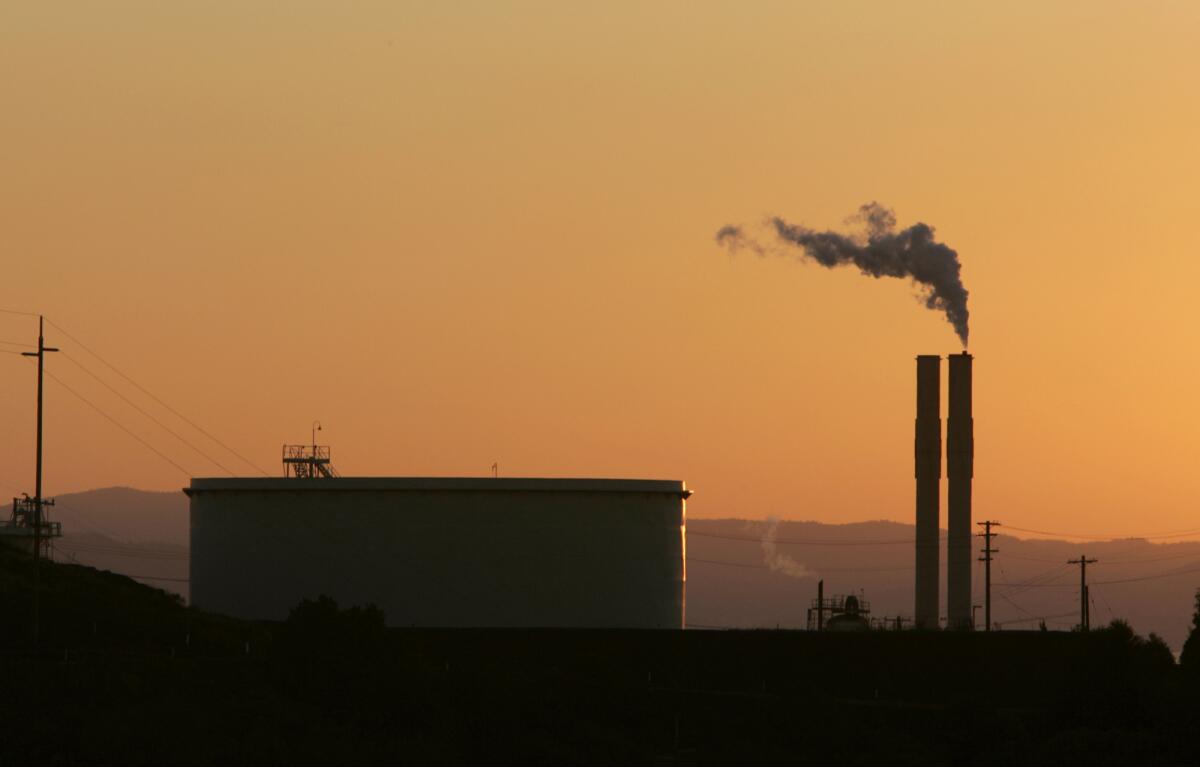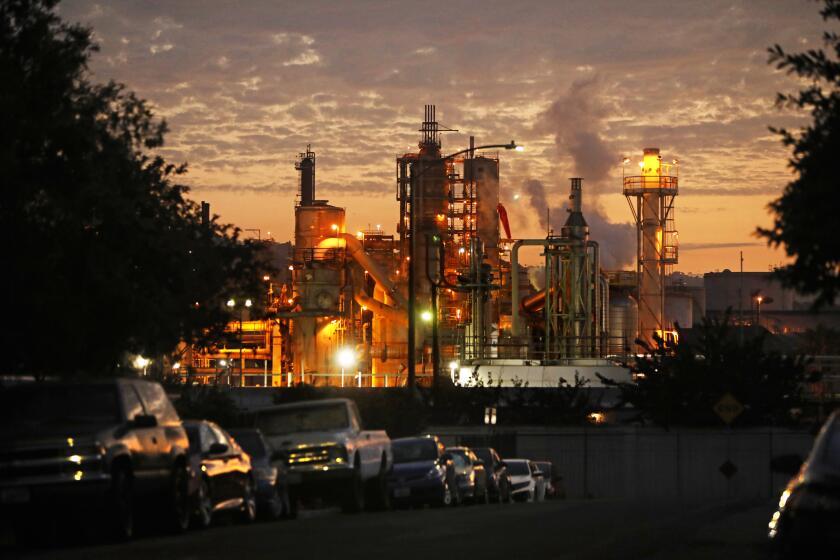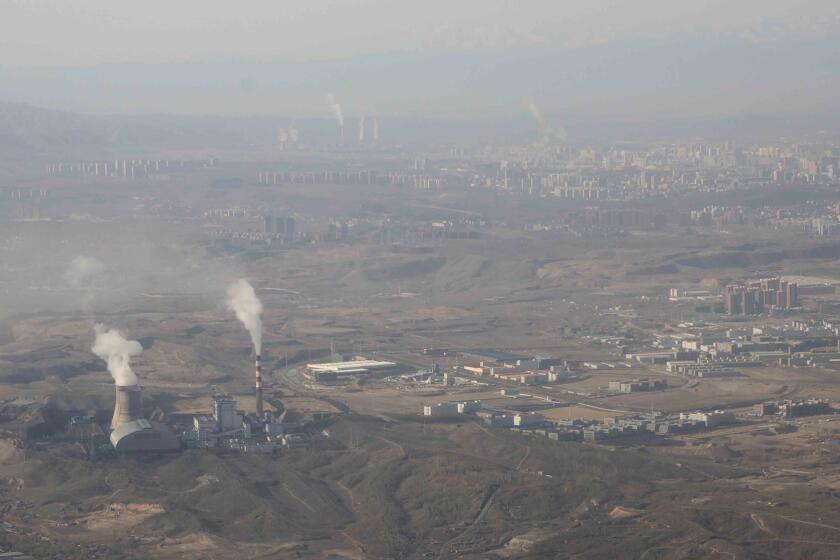Saved-up pollution credits may hamper California’s climate goals, report warns

- Share via
SACRAMENTO — Oil refineries, utilities and other companies that must pay to emit greenhouse gases in California have saved up so many credits allowing them to pollute that it may jeopardize the state’s ability to reach its ambitious climate goals, according to a report by a panel that advises state officials.
California runs one of the world’s largest carbon markets, known as “cap-and-trade,” which requires companies to buy, trade or receive pollution “allowances” equivalent to how much they plan to emit. The state makes fewer allowances available over time, with the goal of spurring the companies to pollute less as allowances become scarcer and more expensive.
California’s market has been closely watched by both advocates and critics of efforts to control emissions using market forces, not mandates. The state is required to reduce emissions 40% below 1990 levels by 2030, an ambitious target, and the state has previously said more than one-third of those reductions will come from cap-and-trade.
But companies that participate have saved up so many allowances — 321 million — that it could hurt the program’s ability to force significant emissions reductions, according to a report finalized last week by the Independent Emissions Market Advisory Committee, a group of five experts appointed by lawmakers and the governor. The banked allowances are roughly equivalent to all the carbon the companies emit in a year, and they so far exceed the emissions cuts that cap-and-trade is supposed to achieve by the time it expires in 2030.
“If you can’t take that as a wake-up call, you’re not paying attention,” said Danny Cullenward, a lawyer and economist focused on climate policy who serves as the committee’s vice chair.
The report comes as the California Air Resources Board is preparing an assessment of the state’s progress toward its climate goals, known as a scoping plan. It’s the first such plan in five years, and the committee urged the board to thoroughly look into the role cap-and-trade should play.
Climate credits sold to California polluters bring billions to landowners. But scientists ask if that’s an environmental investment or a Ponzi scheme.
“Because of the size of the bank, it’s plausible that all the covered sources don’t reduce emissions at all over the course of the decade,” committee Chairman Dallas Burtraw said.
One allowance is one metric ton of carbon dioxide-equivalent emissions, about the same level of emissions produced by driving a car 2,500 miles. During last year’s quarterly allowance auctions, one allowance cost between $17 and $28.
The air board does not make public who holds banked allowances, and there is a limit on how many an individual emitter may possess. If the program expires in 2030 as planned, companies would no longer need to pay to pollute and any outstanding allowances would be useless.
Rajinder Sahota, deputy executive officer for climate change and research at the air board, said it has tools to ensure banked allowances don’t jeopardize the program’s goals, such as selling fewer in future auctions or taking them off the market if they don’t sell for 24 months.
A federal report warns that America’s coasts will be hit hard by ever faster sea level rise between now and 2050.
Sahota said the air board already took some allowances out of the auction market in response to the large bank of credits. That’s similar to approaches that have been taken in other carbon markets in Europe and the northeastern U.S.
“The fact that we have some unused allowances is actually a good thing from the perspective of the atmosphere, because that means those emissions didn’t happen,” she said.
Companies covered by cap-and-trade collectively emitted less between 2018 and 2020 than they did from 2015 to 2017, air board data show. The beginning of the pandemic saw a decrease in economic activity that accounts for some of those reductions.
Shell Energy and the California Council for Environmental and Economic Balance, a coalition of labor and business groups, warned against altering the amount of allowances through any new measures, saying such a move would disrupt the “market integrity” of the program.
At the height of the pandemic last year, emissions were down to 34.8 billion metric tons; this year’s jump is 4.9%, according to updated calculations by Global Carbon Project.
The air board’s last scoping plan found that cap-and-trade would be responsible for 38% of the state’s emissions reductions — essentially anything that can’t be achieved by those other programs. The 2022 update will likely diminish the role of cap-and-trade, Sahota said.
Any changes to the program and the amount of allowances sold would have ramifications beyond cap-and-trade. The state has brought in more than $18 billion through quarterly auctions of allowances, and it goes toward other programs designed to cut emissions. One-quarter of the auction proceeds goes directly to the state’s long-delayed and vastly over-budget high-speed rail project.
California launched the program in 2013 and originally set it to expire in 2020. But in 2017, lawmakers and then-Gov. Jerry Brown extended it through 2030. Environmental justice advocates have long argued against it, saying it does little to improve air quality for people who live next to large polluters.
“The dangerously high number of offsets and allowances reported by the [committee] should sound an alarm for Californians and state leaders,” Neena Mohan, climate justice manager for the California Environmental Justice Alliance, said in a statement.
Toward a more sustainable California
Get Boiling Point, our newsletter exploring climate change, energy and the environment, and become part of the conversation — and the solution.
You may occasionally receive promotional content from the Los Angeles Times.
“Offsets” are projects aimed at removing carbon from the atmosphere, and companies can use a limited amount instead of carbon allowances. The offset projects don’t have to occur in California and can include projects that capture methane emissions at coal mines.
State Sen. Bob Wieckowski (D-Fremont) said he should have pushed harder to bar companies from keeping saved allowances after 2021, forcing them to start afresh. He will lead a Feb. 23 Senate hearing on the scoping plan and said he would question air board and Newsom administration officials about cap-and-trade.
The air board’s 2017 analysis only modeled the possibility of about 150 million allowances — fewer than half of what’s been saved up.
As the air board readies its new analysis, Cullenward said a clear-eyed assessment of where things stand is necessary for California to maintain the integrity of its climate change goals.
“If California is going to live up to those ambitions and demonstrate a model for getting this done, we have to be able to tell people what we’re doing, and we have to be honest with ourselves,” he said.
More to Read
Sign up for Essential California
The most important California stories and recommendations in your inbox every morning.
You may occasionally receive promotional content from the Los Angeles Times.













